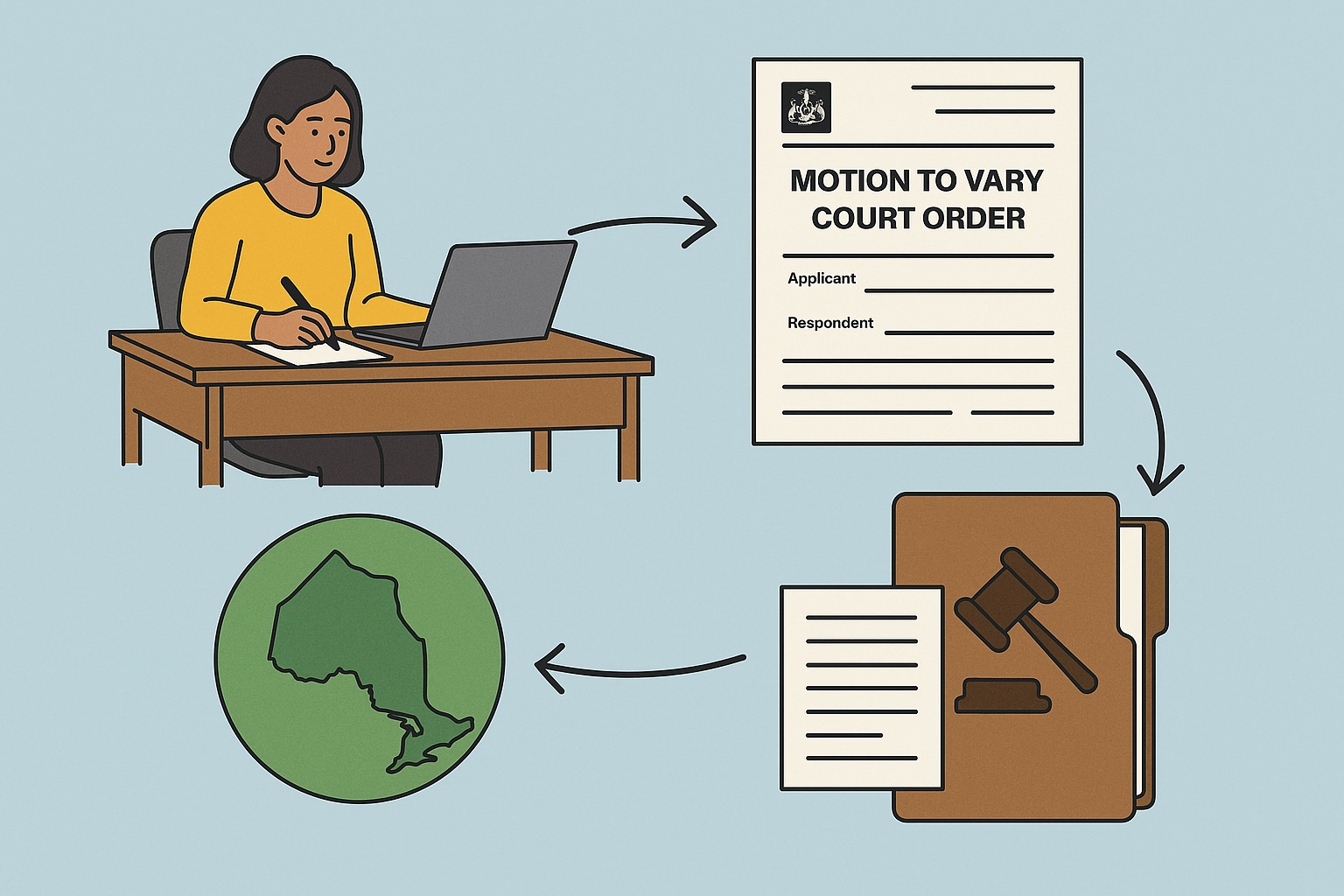How to File a Motion to Vary a Court Order in Ontario (Form 8B)
Need to change a family court order in Ontario? Learn how to file Form 8B — Motion to Vary Order — including who can use it, when to file, and what evidence you’ll need to support your case.

## 🔄 How to File a Motion to Vary a Court Order in Ontario (Form 8B)
Court orders in family law aren't necessarily final forever. If your circumstances have changed — such as income, parenting schedules, or safety concerns — you can ask the court to **vary (change)** a previously issued order by filing a **Motion to Vary Order** using **Form 8B**.
Here’s everything you need to know about using Form 8B in Ontario.
***
### 🧾 What is Form 8B?
**Form 8B – Motion to Change (Vary) Order** is used to ask a family court to legally change an existing order related to:
* Child custody or access
* Parenting time or responsibilities
* Child or spousal support
* Restriction clauses (e.g., no contact)
* Exclusive possession of the family home
> 📄 [Download Form 8B (PDF)](https://www.ontariocourtforms.on.ca/static/media/uploads/courtforms/family/08b/flr-8b-e.pdf)
***
### ❓ When Should You File Form 8B?
You should file a Motion to Vary Order if:
* There’s a **significant change in circumstances**
* You or the other party are **not following the current order**
* A child’s **needs, age, or schedule** have changed
* You’ve lost your job or experienced a major income shift
* The other party has moved or relocated
> ⚠️ Minor disagreements are not enough — the change must be material and ongoing.
***
### 📋 What You’ll Need to File
* ✅ [Form 8B – Motion to Vary Order (PDF)](https://www.ontariocourtforms.on.ca/static/media/uploads/courtforms/family/08b/flr-8b-e.pdf)
* ✅ [Form 35.1 – Affidavit in Support of Parenting Claims](https://www.ontariocourtforms.on.ca/static/media/uploads/courtforms/family/35-1/flr-35-1-e.pdf) *(if custody/parenting is involved)*
* ✅ Updated financial disclosure if support is being changed
* ✅ Supporting documents (T4s, medical reports, school letters)
***
### 📝 How to File Form 8B in Ontario
1. **Complete Form 8B** Clearly state what part of the order you want to change and why.
2. **Gather Supporting Evidence** Include financials, affidavits, or third-party records that justify the change.
3. **File with the Court** Submit Form 8B at your local **Ontario Family Court**. You may be able to e-file depending on your region.
4. **Serve the Other Party** Deliver a copy of your filed documents to the respondent and file a [Form 6B – Affidavit of Service](https://www.ontariocourtforms.on.ca/static/media/uploads/courtforms/family/06b/flr-6b-e.pdf).
5. **Attend the Motion Hearing** A judge will review your motion and decide whether to grant the variation.
***
### 📌 Summary: Filing Form 8B to Vary a Court Order in Ontario
* ✅ Use **Form 8B** to ask the court to modify an existing family law order
* ✅ Must show a **material change in circumstances**
* ✅ Support your request with **documents and affidavits**
* ✅ Serve the other party and **file proof of service**
* ✅ Attend court for the **motion hearing**
***
### 🧾 Related Forms
* [Form 8B – Motion to Vary Order (PDF)](https://www.ontariocourtforms.on.ca/static/media/uploads/courtforms/family/08b/flr-8b-e.pdf)
* [Form 6B – Affidavit of Service (PDF)](https://www.ontariocourtforms.on.ca/static/media/uploads/courtforms/family/06b/flr-6b-e.pdf)
* [Form 35.1 – Affidavit (Parenting Claims)](https://www.ontariocourtforms.on.ca/static/media/uploads/courtforms/family/35-1/flr-35-1-e.pdf)
***
### 📞 Where to Get Help
* **Legal Aid Ontario** – 1-800-668-8258
* **Family Law Information Centres (FLIC)** at your local courthouse
* **Community Legal Clinics** – Help low-income families file motions
* **Women’s Shelters** – Legal support for custody and protection matters
***
***
### Frequently Asked Questions (FAQs)
#### 1. What is a "material change in circumstances"?
A material change is a significant, long-lasting change to your situation that was not predictable when your original court order was made. Examples include a major promotion or job loss, a long-term illness, or a parent needing to relocate for work.
#### 2. Can I use Form 8B to change a court order?
No. Form 8B is an *Answer* to an initial court application. The correct form to *start the process* of changing a final court order is Form 15: Motion to Change.
#### 3. What happens if the other person agrees to the change?
If the other person agrees with the changes you are proposing, you can file the paperwork together using a Form 15C: Consent Motion to Change. This is a much faster and simpler process that usually does not require a full court hearing.
#### 4. Do I need a lawyer to file a Motion to Change?
While you can file on your own, changing a court order is a complex legal process. The test for a "material change" can be difficult to meet. It is strongly recommended that you seek legal advice from a family lawyer or Legal Aid Ontario to ensure your case is as strong as possible.
#### 5. How long after an order is made can I ask to change it?
There is no set time limit, but you must be able to prove a *material change* has occurred *since* the last order was made. You cannot re-argue the same facts that the judge already considered.
#### 6. What happens if I file a Motion to Change without a good reason?
If a judge finds that there has not been a material change in circumstances, your motion will be dismissed. The judge could also order you to pay some or all of the other person's legal costs for having to respond to an unnecessary motion.
